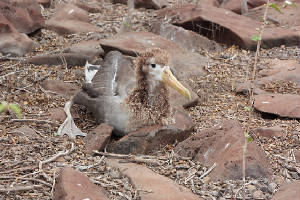The Galapagos Islands are famous for their unique flora and fauna. I have arranged the pictures in accordance with their general grouping, such a sea birds, amphibians, etc. They are not in the order in which I saw or photographed them.
| Galapagos Penguin |
Literally wall-to-wall birds.
The Waved Albatross is the largest bird that breeds in the Galapagos. It’s wingspan can exceed 7 feet (2.35 meters)
)
if they feel another bird is invading their territory
What at first glance appears to the a cemetery with headstones is actually an albatross nursery.
They do not prepare nests. They simply lay an egg on the ground and then proceed to hatch it.
Both are incubated but on hatching the stronger of the chicks will push the weaker out of the nesting area and it will succumb.
Survival of the fittest.
Settling down to Mom duties, or maybe Daddy duties. The egg is incubated by both the male and female parent.
After it hatches, the chick is fed by both parents.
 |
| File Photo |
It is easy to see where aircraft manufacturers came up with the idea of curved wing tips.
The Tropicbird nests in crevices in rock walls and feeds on fish and other sea life.
 |
| file photo |
The frigate will grab the tropicbird’s tail feathers and shake it, causing the tropicbird to disgorge the fish
The frigate catch the fish in midair or on the water surface and eat it. I saw this happen but was too far away to get a photo.
this large bird is an expert fisher. Sitting on a ledge over the water or lazily flying it spots a fish, folds its wings and dives.
Just before it hits the water it opens its beak and then strains out seawater from its catch.
Ready